
This time last year we were experiencing extremely high fertilizer prices that were continually rising. Fertilizer prices had been steadily increasing throughout 2021 and then experienced an acceleration after the Russian invasion of Ukraine in February 2022. Throughout the desert Southwest and across the nation, high prices have continued for fertilizers used in crop production agriculture over the past year. Now in early 2023 fertilizer prices are starting to decline but are still relatively high compared to prices two years ago. These patterns are shown in Figure 1.
There are at least four important lessons or messages from these recent experiences with global fertilizer prices and the impacts at the field level in crop production systems. First, many people have come to recognize that among global nitrogen (N), phosphorus (P), and potassium (K) fertilizer producers China, Russia, and Belarus are major players and are consistently in the top 10 (Figure 2). Our awareness has been heightened in response to the diminished supply available to U.S. markets from these three nations in the past year. The U.S. ranks fourth in overall N, P, and K fertilizer production.
Secondly, as fertilizer use has increased in many parts of the world in the past 60 years, the U.S. now represents only 10% share of the global use of N, P, and K fertilizers (Figure 3).
The third point that has been emphasized and has become increasingly clear to the crop production industry, is the connection between fertilizer production input costs, particularly natural gas, and fertilizer prices (Figure 4). Fertilizer production facilities require a large amount of energy to convert the raw chemical materials into their applicable farm-use state. This is very important in terms of N fertilizers.
Regarding prospects for global fertilizers, experts in the industry have the common variance in points of view but there seems to be a general agreement that higher prices have been a function of reduced supply and that was further exacerbated by the Russia-Ukraine war, the loss of a major port for Belarus potash fertilizer, and the P fertilizer supply constraints from China (Baffes and Koh, 2023).
These pressures are not going away soon, but the impacts have diminished in recent months. The constraints on supplies of P and K fertilizers are expected to continue for quite some time into the future. Price reductions have been most notable for N fertilizers, primarily due to lower natural gas prices in Europe compared to 2022.
Crop Nutrient Management
The fourth point of emphasis regarding fertilizer prices and desert crop production systems has been the shift towards more conservative management of fertilizers in the field.
Developing a conservative approach to nutrient management is often considered a risky venture in crop production systems, particularly with a short season crop like a leafy green vegetable that has a premium on quality as well as yield. However, under high fertilizer price conditions and/or tight supply, there is a greater incentive to develop and employ a more conservative approach to nutrient management.
To maximize nutrient management efficiency, the 4R concept of plant nutrient management and application can be helpful. The 4R concept consists of applying:
1. The Right fertilizer source at the
2. Right rate, at the
3. Right time and in the
4. Right place
Along with the 4R nutrient management approach, an assessment of plant-available forms of the nutrients present in the soil by evaluating soil tests with appropriate indices is a good step in the development of a more efficient nutrient management program. Then splitting nutrient applications, particularly mobile nutrients such as N in line with crop uptake and utilization patterns are good steps towards higher fertilizer use efficiency by the crop. Thus, timing, methods, and rates of nutrient applications are critical (i.e., 4R management).
In agriculture we know quite well that we have no control over markets and the costs of crop production inputs. However, we can control these inputs in the field, and we do have some tools at our disposal that can be helpful in the process.
References:
Baffes, J, W. C. Koh. 2023. Fertilizer prices ease but affordability and availability issues linger. 5 January 2023, World Bank. https://blogs.worldbank.org/opendata/fertilizer-prices-ease-affordability-and-availability-issues-linger
Crawford, A, F. Jomo, E. Elkin, and M. Bristow. 2023. World’s fertilizer market in turmoil. Bloomberg, Farm Progress, 20 February 2023. https://www.farmprogress.com/crops/world-s-fertilizer-market-in-turmoil
Quinn, R. 2023. DTN retail fertilizer trends. DTN Progressive Farmer, 15 March 2023.
https://www.dtnpf.com/agriculture/web/ag/crops/article/2023/03/15/anhydrous-uan-move-even-lower?referrer=NLSnapshot
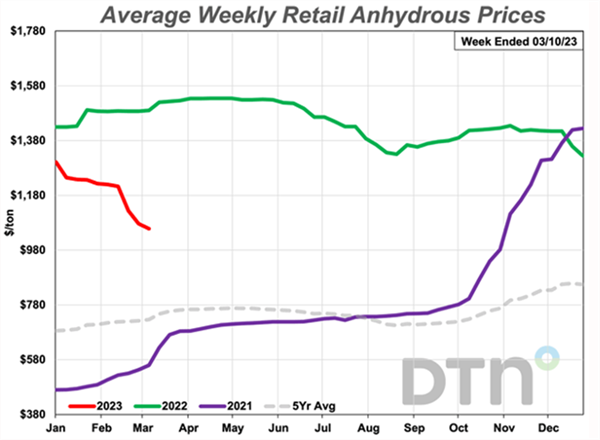
Figure 1. Average weekly retail prices for anhydrous ammonia (82% N), for
2021, 2022, and through 10 March 2023. Source: DTN/Quinn, 2023.
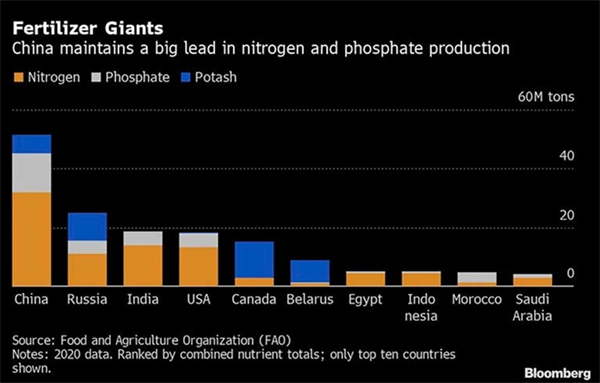
Figure 2. Ranked nitrogen, phosphorus, and potassium fertilizer production by
country. (FAO and Bloomberg graphics). Crawford et al., 2023.
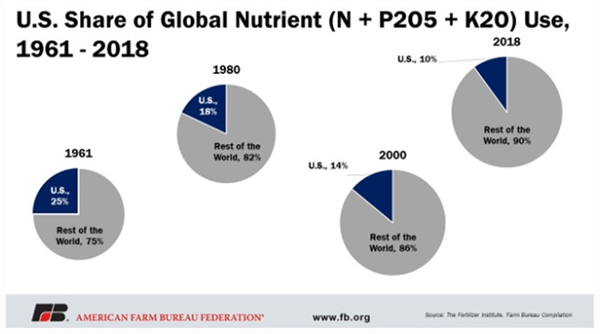
Figure 3. Pattern of U.S. share in the global nutrient market since
1961. Source: Farm Bureau.
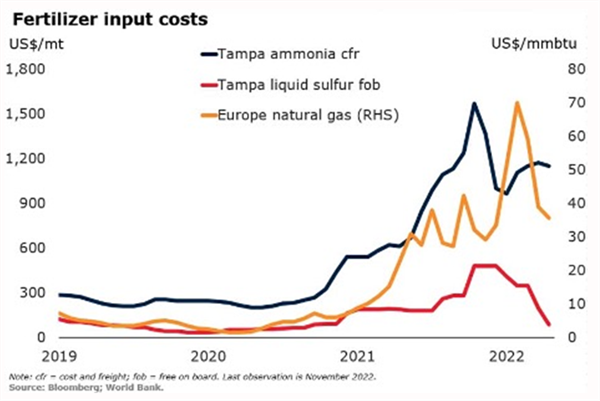
Figure 4. Fertilizer input cost trends, 2019-2022. Source: Bloomberg; World
Bank. Baffes and Koh, 2023.
Frost and freeze damage affect countless fruit and vegetable growers leading to yield losses and occasionally the loss of the entire crop. Frost damage occurs when the temperature briefly dips below freezing (32°F).With a frost, the water within plant tissue may or may not actually freeze, depending on other conditions. A frost becomes a freeze event when ice forms within and between the cell walls of plant tissue. When this occurs, water expands and can burst cell walls. Symptoms of frost damage on vegetables include brown or blackening of plant tissues, dropping of leaves and flowers, translucent limp leaves, and cracking of the fruit. Symptoms are usually vegetable specific and vary depending on the hardiness of the crop and lowest temperature reached. A lot of times frost injury is followed by secondary infection by bacteria or opportunist fungi confusing with plant disease.
Most susceptible to frost and freezing injury: Asparagus, snap beans, Cucumbers, eggplant, lemons, lettuce, limes, okra, peppers, sweet potato
Moderately susceptible to frost and freezing injury: Broccoli, Carrots, Cauliflower, Celery, Grapefruit, Grapes, Oranges, Parsley, Radish, Spinach, Squash
Least susceptible to frost and freezing injury: Brussels sprouts, Cabbage, Dates, Kale, Kohlrabi, Parsnips, Turnips, Beets
More information:
For those of you interested in the latest thoughts on ag technology, you might want to check out the keynote address given by John Deere1 at CES 2023 earlier this week. The presentation can be found on YouTube at: https://youtu.be/1kjZMHZl538. As you might expect, there is a fair amount of company self-promotion, but it is interesting to hear their view on the current state and future of agricultural technologies. A couple of key takeaways for me were that telematics and computer vision systems will play key roles in the future and that increased precision will continue to be a focus.
[1] Reference to a product or company is for specific information only and does not endorse or recommend that product or company to the exclusion of others that may be suitable.
In the year 2000 Weed scientist and Area Agriculture Agent Barry Tickes from the University of Arizona Yuma Agricultural Center conducted many evaluations to determine the best application method for Pronamide Herbicide (Kerb) in lettuce. His studies revealed that in the low desert the product was losing significant efficacy because it was applied right after planting and before starting sprinkler irrigation. Pronamide is very soluble in water and was often leached below weed seeds prior to their germination.The goal of these projects was to delay the application of the product to have it available at the right time for weed germination. To do this Tickes stopped the sprinkler irrigation at different timings before weed germination and sprayed plots with a CO2 experimental backpack in the mud.
He demonstrated that Kerb applications should be delayed from 1 to 6 days after starting sprinklers depending on the time of the season. Delayed applications at the time were done with aerial applications, but after the terrorist’s attacks 21 years ago all air traffic was suspended. Then PCAs asked if the product could be chemigated (applied through the sprinkler irrigation). To answer this question Tickes conducted several trials in Yuma.
Surprisingly the results revealed that the product performed better chemigated than applied by air. Today most of the Kerb in Arizona is chemigated and applied in delayed applications, also the method is extensively used in California.
It all started with a little trial in a Yuma Experiment Station that demonstrated delayed applications work. Then 9/11created the circumstances that forced the industry to take that course. If you would like to review the original data from this research please visit: Timing Kerb Applications in Lettuce and Evaluation of Kerb Applied by Sprinkler Irrigation to Lettuce both by Barry Tickes.
Timing Kerb Applications in Lettuce
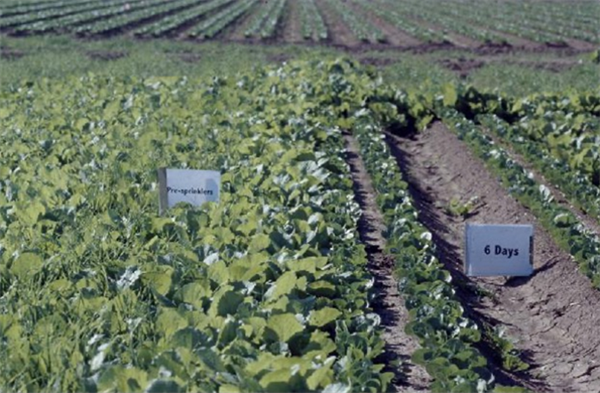
Results of pheromone and sticky trap catches can be viewed here.
Corn earworm: CEW moth counts remain at low levels in all areas, well below average for this time of year.
Beet armyworm: Trap increased areawide; above average compared to previous years.
Cabbage looper: Cabbage looper counts decreased in all areas; below average for this time of season.
Diamondback moth: DBM moth counts decreased in most areas. About average for this time of the year.
Whitefly: Adult movement beginning at low levels, average for early spring.
Thrips: Thrips adult counts reached their peak for the season. Above average compared with previous years.
Aphids: Aphid movement decreased in all areas; below average for late-March.
Leafminers: Adults remain low in most locations, below average for March.